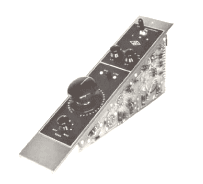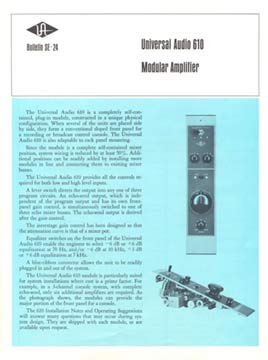Universal Audio WebZine
Volume 2, Number 7, August 2004
[UA Universe] [Ask the Doctors] [Digital Discourse] [Analog Obsession]
[Support Report] [The Channel] [Digi-Talk] [Analog Dialog] [Featured Promotion]
[Graphic-Rich WebZine]
[Back Issues] [UA Home]
Analog Obsession: History of the 610 Preamplifier with Paul McManus
"Bill Putnam, to me, is truly the father of recording, because many of the techniques, and, indeed, the way [modern studio] equipment is made, began in his mind. Stuff we take for granted, like the design of modern consoles, how components are laid out and how they function, cue [headphone] sends, echo sends and returns, multitrack switching-this all came out of his imagination."
-Bruce Swedien, taken from Temples of Sound Chronicle Books, 2003.
This month focuses on the origins of the Universal Audio 610 mic pre, whose re-issue has become UA's most popular preamp design. Launched in April 2001 as the 2-610 two channel unit, then finding it's way into the market as the M610 (mono) and ultimately experiencing overwhelming success as the 6176 Channel Strip, the 610 has found a new market over forty years after its introduction. Universal Audio's 2-610, M610 and 6176 are based on the design of the original 610 mixing console first produced by Bill Putnam Sr. in the late 1950's.
"Unlike today, in 1960 there were very few recording studios and they were mostly owned by the major record companies. Almost all recording consoles of the day were custom built using lever key switches, transformers and vacuum tube amplifiers."
The McManus Connection
Let me introduce Mr. Paul McManus; Paul is a working stiff audio engineer like the rest of us, and just got off the road from a fifty day, 12,000-mile tour with none other than J.J. Cale, in support of his new record. Paul is also card-carrying AES member and an avid vintage gear guy. At the 109th convention in 2000, Paul helped put together a great presentation called "When Vinyl Ruled" that featured his vintage 1960 custom UA 610 console. The presentation had tons of other vintage gear that re-created a 1960's 3-track control room. Paul was able to share some of his insight into the history of the 610.
 |
|
Modular 610-A channel strip
|
Bill Putnam is often credited as the originator of the modular console; his designs ultimately surfaced as the 610 console. The 610 was groundbreaking because individual channels could be replaced instantly, keeping the sessions rolling despite a bad channel at the desk. This was ideal for the huge volume of sessions that Bill's studios managed. But it made sense to make this design available to other studios as well, so the 610 modular amplifier became one of Universal's flagship products, revolutionizing the mixing console.
Why else was it so revolutionary? It was the beginnings of "off the shelf" mixers. McManus explains: "Unlike today, in 1960 there were very few recording studios and they were mostly owned by the major record companies. This meant there was a very small market for recording equipment. Almost all recording consoles of the day were custom built using lever key switches, transformers and vacuum tube amplifiers. First an engineer had to come up with a viable block diagram and gain chart, then have a large piece of metal panel machined to attach all the components to. Next came the wiring and soldering, and finally the testing."
 |
|
The first console built for modern recording--Universal in Chicago, circa 1950
|
"To the best of my knowledge, UA never sold mainframes (the additional chassis and controls for the console) as a commercial product. Complete consoles were not offered either as a commercial product either. Which means that just about all UA tube 610, 610-A consoles were all still one off custom creations built to meet the needs of United and Western studios.
However, a few other consoles were custom built by UA using these components--I can think of four: Ray Charles had one, Hawaii Calls (Webbley Edwards) had one for their TV show (this one is at Ocean Way now), and Valentine Recording also had one, and Frank Sinatra had one in Palm Springs.
They may have built a few more, but I would say that overall probably no more
than 25 total 610/610-A consoles were built by UA, which is not very many. To think that just a handful of consoles was responsible for so many hit records in such a short period of time!
Later on the Studio Electronics/UA folks built many other custom consoles, but not using 610-A modules. First they used 1008 mic amps, a fader, a 508 eq, buss switching and 1016 line amps. Later they used a 1108 amps in place of both the 1008 and 1016 amps."
610 Features
Not only was the 610 preamp modular --and a great sounding mic/line amplifier-- it has other innovative features that Bill had pioneered in his early custom consoles, which ultimately ended up in the 610. McManus elaborates: "Each module was built on a plug in chassis and featured a mic preamp with switchable line pad, low and hi frequency equalization, and an echo send. The plug in modular output line amplifiers are capable of delivering a healthy +30 dBm, so headroom is not a problem."
"My original 610 modules were all custom made in late 1959 or 1960 for use at United studios, and are much earlier than the 610-A modules. The major difference is that mine can only be used in a console frame, there is no provision for rack mounting. Another key point, the 610-A has switching for 3 program busses and 3 echo busses on the module (the L-M-R switch), and my earlier modules have no buss switching at all, which makes them physically shorter than 610-A modules. My console has all switching functions in the mainframe, along with metering for program and echo, monitor controls, and sub and master faders."
A little more history on Paul's 610 console
Paul McManus has been a great historical resource for the new Universal Audio, and his interest in preserving the past is inspiring.
 |
|
Paul's 610 Console
|
"Wally Heider (before he started his own studio) was the manager of remote recording for both United and Western studios, and this console was used to record many artists, including Wes Montgomery, the Smothers Brothers, and the Doors. My console also was the one used for the MC5's classic album 'Kick Out the Jams.' Bruce Botnick used a 3M 1" 8 track along with my console that he had flownin by Wally Heider from Los Angels to record the MC5 live in the Grande Ballroom in Detroit on Halloween 1969."
"When [I] got the console in the mid 1980's, it had not been used since the early 1970s, and was in very poor condition. Mice had chewed through some of the wiring, every tube and capacitor was shot, there were no power supplies and not one piece of paperwork on it. Over a very leisurely period of time (about 4 years) [I] slowly rebuilt it. The most time-consuming part was tracing each wire and circuit to draw up proper schematics and diagrams. By the way, my console looks almost identical to the one that was in Western's famed Studio 3."
-Will Shanks
 |
|
Original 610 cut sheet
View the whole 1967 catalog via .pdf |